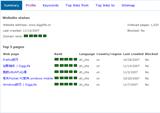What is pseudo-static? How to understand pseudo-static in SEO?
Today, let's join SWJ from Shanghai SEO to discuss one of the topics that everyone is concerned about: "pseudo-static"! So what is pseudo-static? What are the benefits of pseudo-static? Is pseudo-static beneficial for SEO? And other related questions!
First, I will share an official-style explanation of pseudo-static:
### What is Pseudo-Static?
Pseudo-static refers to dynamic web pages rewriting their URLs to remove dynamic parameters, but in reality, there is no need to actually create the rewritten pages in the web directory.
### Two Ways to Generate Pseudo-Static Pages (There are other methods, but here we introduce two common ones):
1. **Frame-based Pseudo-Static**: This method is very simple and easy to identify. The principle is straightforward—create a static main frame page and link dynamic content into a sub-frame. You can easily tell this by looking at the URL. If all the URLs on the website are the same, it is definitely a frame-based pseudo-static system. (The DZ forum from Discuz seems to use this type of pseudo-static approach.)
2. **Component-based Pseudo-Static**: This method uses a component to forcibly display ASP files with an .htm extension. For users, it’s hard to distinguish because the displayed links indeed end with .htm. However, if you carefully observe the links, you might notice some clues. These URLs often look strange, containing traces of ASP and some hidden parameters. To find out its true form, check the program files and look for web pages matching the URL. Since .htm pages should exist physically, if you can't find such a page, it is undoubtedly a pseudo-static page.
### What Are the Benefits of Pseudo-Static? (SWJ's Plain Answer!)
We implement pseudo-static for several reasons:
1. **Mainly to cater to search engines**: It makes it easier for search engine spiders (Spider) to crawl relevant content on web pages.
2. **User-friendly website access**: A good webpage, if dynamic, may not be trusted as much when shared between users. However, if it appears as a static page, users tend to trust it more. Also, pseudo-static suffixes usually follow similar patterns, so you can easily tell whether it’s pseudo-static or truly static.
3. Haven’t thought of any more yet… If anyone has ideas, please let SWJ know. Thanks!
### Is Pseudo-Static Beneficial for SEO? How is Pseudo-Static Defined in SEO? (Let’s do a small pseudo-static experiment together with SWJ!)
In influencing a website's ranking in search engines, one crucial factor is webpage staticization. Many friends studying SEO encounter technical barriers, and pseudo-static becomes the biggest hurdle.
We know that in SEO optimization, `new_1234.html` is easier to index than `new.asp?id=1234`. For friends with independent servers, you can use the ISAPI_Rewrite method to write pseudo-static rules. For those with only virtual hosting, you may have to rely on some ASP-to-HTML generation systems to help you. Today, we will focus on using ISAPI_Rewrite to build pseudo-static pages.
#### Step 1:
First, download ISAPI_Rewrite. You can search for it online; I won't provide a download link here. You can find both simplified and full versions. The simplified version can only configure server-wide settings, while the full version allows configuring pseudo-static rules for individual websites on the server. For personal site owners, the simplified version is sufficient.
#### Step 2:
After downloading, locate the `.msi` file in the installation package and install it.
#### Step 3:
Open Internet Information Services (IIS), right-click, go to Web Site Properties, click the ISAPI Filters tab, and add a filter. You can name it anything you like, specify the path to `ISAPI_Rewrite.dll`, and confirm.
OK, now let's create a test page called `new.asp` with the following code:
```asp
```
Then, in your browser, enter:
```
http://127.0.0.1/new.asp?id=1234
```
You should see the text "1234" on the webpage, indicating that the test was successful.
Now, let's configure ISAPI_Rewrite:
Open the ISAPI_Rewrite directory, remove the read-only attribute of `httpd.ini`, and open it for editing. We want to change `new.asp?id=1234` to something like `new_1234.html`. Therefore, we need to add the following line to `httpd.ini`:
```
RewriteRule /new_([0-9,a-z]*).html /new.asp\?id=$1
```
Save the changes, and now you can test this URL: `http://127.0.0.1/new_1234.html`.
You should see the text "1234" on the page, meaning the pseudo-static configuration was successful!
Of course, the above is just a simple example. Depending on the actual situation, there are also directory-based and paginated types, among others...



